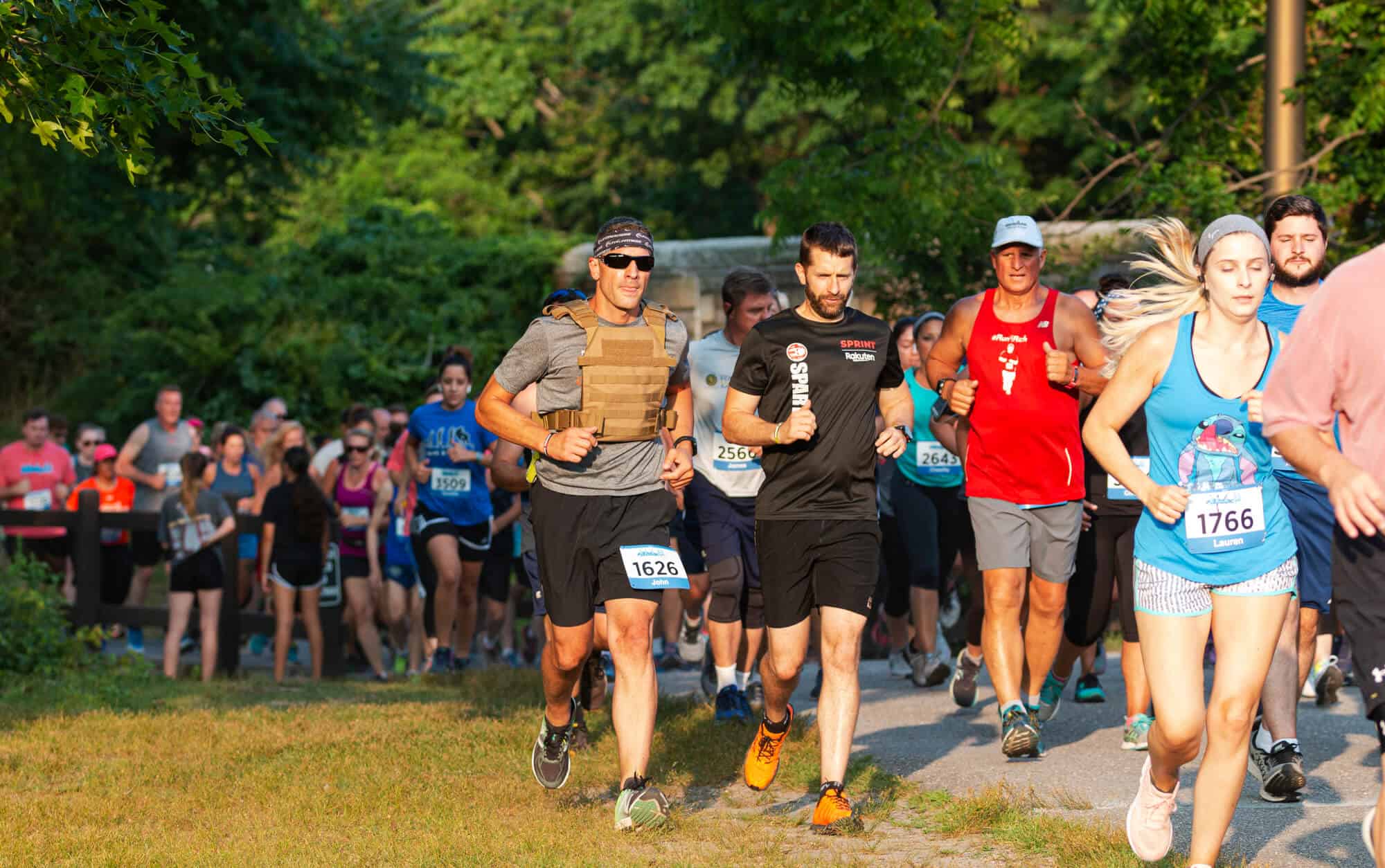So, you’ve run several 5K and 10K races and worked hard on your PR, but you still want to make a certain achievement to feel more accomplished.
Your ambitious soul won’t simply settle down until you’ve run a 16 minute 5K!
While being a big challenge that requires a high level of discipline and an intense training schedule, it’s not impossible to make it to a 16 minute 5K.
In this article, we’ll put together a comprehensive guide to help you get there. We’ll also answer a few related questions that may be on your mind.
So, are you ready to dive in?
What Should My Target Pace Be in Order to Run a 16 Minute 5K?
Before knowing the smallest details about how to prepare for a 16-minute 5K, you may want to have a clear idea of what your pace should be throughout the race.
If you do your calculations, which is simple math, you’ll find out that you must run at a velocity that’s a bit higher than five minutes and ten seconds per mile for the entirety of the 3.1-mile race.
Of course, that’ll be slightly faster than your typical 5K pace, and this is where the challenge lies.
Want to translate this value to something more accurate, say, the speed on a treadmill?
Well, you should aim for a speed of 11.6 mph throughout the 5K race to reach the finish line in only 16 minutes.

How Long Will It Take Me to Prepare for a 16 Minute 5K?
Because this challenge requires an elevated physique, you won’t be able to wrap up the training in a month, two, or even three. Of course, this is the case if you’re still a beginner runner since your body won’t be prepared for the intense workout.
People who have just taken up running might require eight months to a year of practice until they’re able to run a 5K in only 16 minutes. It’s definitely not easy to reach that speed in a shorter amount of time.
Even advanced marathon runners should have achieved certain milestones in their experience to be ready for a 16 minute 5K. So, how can you tell if you’re in the right category to start training for a 16 minute 5K?
While there are no strict rules for this, there’s a good way to see if your body can endure this physical challenge. Simply, try running an entire mile at your target race pace, which is 11.6 mph, without slowing down or taking breaks.
If it goes without trouble, then you’ll be ready to follow our 16 minute 5K training plan!
If not, it’s best to adjust your body to a 22-minute 5K plan followed by an 18-minute 5K training program. Building your endurance slowly is the right way to go about this to avoid strained muscles, injuries, and the like.
What’s the Best Training Plan to Follow to Prepare for a 16 Minute 5K?
In this section, we’ll introduce you to a tried-and-true one-month training program to help you fulfill your 16 minute 5K dream. If you fit into the criteria we’ve mentioned earlier, keep in mind that you’ll need to start the following plan three or four months before the 5K race.
Again, this isn’t a solid rule since the preparation time is entirely based on your fitness level and endurance.
With those points in mind, let’s take a look at the 16 minute 5K training schedule, shall we?
Week 1
| Day 1 | Run at an easy pace for 30 minutes |
| Day 2 | ● Run for half a mile (4 repeats) at a speed of 5:10 minutes per mile
● Make sure to take 90 seconds of rest between repeats (light jogging) |
| Day 3 | Run at an easy pace for 30 minutes |
| Day 4 | Do some hill sprints (4 repeats with 2 to 3 minutes for recovery) |
| Day 5 | Rest or take up cross-training |
| Day 6 | Run at an easy pace for 30 minutes |
| Day 7 | ● Run for 3.1 miles (the 5K distance)
● Begin with a light jog, then shift to a medium pace, then run at your target 5K pace |
Week 2
| Day 1 | Run at an easy pace for 30 minutes |
| Day 2 | ● Run for 400 meters (10 repeats) at a speed of 5 minutes per mile
● Make sure to take 60 seconds of rest between repeats (light jogging) |
| Day 3 | Run at an easy pace for 30 minutes |
| Day 4 | Do some Kenyan hill workouts (4 repeats with 2 to 3 minutes for recovery) |
| Day 5 | Rest |
| Day 6 | Do a tempo run for 30 minutes |
| Day 7 | ● Run for 3.1 miles (the 5K distance)
● Begin with a light jog, then shift to a medium pace, then run at your target 5K pace |
Week 3
| Day 1 | Do a tempo run for 30 minutes |
| Day 2 | ● Run for half a mile (6 repeats) at a speed of 5:10 minutes per mile
● Make sure to take 90 seconds of rest between repeats (light jogging) |
| Day 3 | Run at an easy pace for 30 minutes |
| Day 4 | Include some Fartlek training sessions |
| Day 5 | Rest or do some cross-training |
| Day 6 | Run at an easy pace for 30 minutes |
| Day 7 | ● Run for 3.1 miles (the 5K distance)
● Begin with a light jog, then shift to a medium pace, then run at your target 5K pace |
Week 4
| Day 1 | Rest or do some cross-training |
| Day 2 | Rest or do some cross-training |
| Day 3 | Do a tempo run for 30 minutes |
| Day 4 | Rest or do some cross-training |
| Day 5 | Run at an easy pace for 30 minutes |
| Day 6 | Rest or do some cross-training |
| Day 7 | Rest or do some cross-training |
As you can see, the final week of this training program focuses on recovery with just a little bit of exercise to keep your body active. It’s important not to push yourself too hard during this week so as not to end up with the bad consequences of overtraining.
How Many Cycles of This Training Plan Should I Do Before Running a 16-Minute 5K?

We recommend repeating this training program for two to three cycles before the big race. But, again, it’s all up to your progress and performance.
If everything goes according to plan and you can easily reach your target pace by the end of the program, you should be ready to participate in that 5K. If you feel like you could use more training, do another cycle.
However, if you find yourself struggling to meet the target pace, then you may want to take things slow. Don’t overexert yourself or take huge leaps, but follow an easier 5K plan until you’re completely prepared for this challenge.
What Kind of Cross-Training Workouts Can I Include in My 16 Minute 5K Exercise Plan?
One of the greatest things about cross-training workouts is that there’s a huge variety of those. Therefore, you’ll have a wide selection of exercises to choose from to increase your muscle strength and, eventually, your stamina as a runner.
In this section, we dive deeper into a few types of cross-training workouts so that you can pick your favorites and incorporate them into your plan.
Cycling
A lot of runners take up cycling as a form of cross-training because it strengthens your hamstrings and glutes more than running does. Better still, it helps you work the same muscles you train while running while putting less strain on your joints.
You can cycle indoors or outdoors, but a lot of people prefer hopping on a spin bike at the gym so that they don’t have to worry about rough trails or bad weather.
To make the most out of your cycling session, start with a warm-up at a quick pace for about ten minutes. Then, gradually build resistance until half an hour has passed. Finally, take five to ten minutes to cool down and restore your normal heart rate.
Swimming
Swimming is another favorite of runners, especially those who’ve recently upped their weekly mileage and are suffering from mild injuries. Swimming can simply boost your muscle strength with almost no strain on the joints.
Also, this sport allows your hip and core muscles to move in directions and ways than the ones associated with running. This increased flexibility can improve your endurance even further.
Wondering how to go about swimming as a runner?
Easy. Just do 30 to 40 minutes of laps. You can also go back and forth in the pool four to eight times while kicking with a kickboard to exercise the muscles of your lower body.
Strength Training
Without a doubt, doing resistance training, whether with gym equipment, free weight, or at-home workouts, can up your running game. By improving your body’s endurance through these exercises, you should end up tolerating longer times and distances.
Here are a few strength-training workouts you could try:
CrossFit

Sure, CrossFit isn’t the typical medium-intensity workout that you’ve been expecting on your rest days. However, you can depend on CrossFit exercises to build your endurance to impressive heights, which is what you’ll need to run a 16 minute 5K.
With its many power-based workouts, CrossFit is a good choice for those who want to work other muscles besides those used for running.
Final Words
Running a 16 minute 5K is definitely not a walk in the park, but it’s not impossible to do either if you’re fully committed to your goal. Just make sure that your fitness level is right before you start training for this major event to be safe from any overtraining injuries.
With the perfect practice plan, good time management, and plenty of additional strength workouts, we’re sure you’ll be able to finish a 5K in 16 minutes.
So, you can finally say hello to a new PR!

